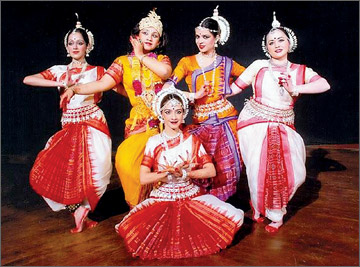Origin and development of Odissi dance
Subashini Pathmanathan
The classical dance form of East Indian province of Orissa is Odissi.
The word Orissa derived its name from Orda Desa. Natya Sastra of
Bharatha Muni is the basic source of Indian and South East Asian dances.
Like all Indian classical dance forms, Odissi is also based on Natya
Sastra and Hindu mythology. This is found in various sculptures,
paintings and inscriptions. The great Jain emperor Karavela was a great
dancer and an accompanist musician.
 |
|
Dances
should be performed according to a certain pattern |
Due to his keen interest in music and dance, he himself arranged
numerous music and dance festivals. In history of Orrisa, due to certain
political changes and instability, the cultural survival and customs of
the State were affected.
The sixth Century AD was a steady period for cultural progress in
Orissa. During the seventh century, for the first time, the dancing
deity lord Nataraja (Siva) temple was built in Orissa. The image of lord
Nataraja found in Orissa differs from the image of lord Nataraja found
in South Indian States.
South Indian image of lord Nataraja is portrayed with four arms. But
in Orissa, different poses of lord Nataraj are depicted differently. The
total number of arms of lord Nataraj differs differently in different
places and temples.
The total number of arms varies from two to ten. This is evidenced by
different Nataraj statues, temple paintings and temple sculptures
depicted differently all over Orissa.
This could be seen in the famed Bhubaneswar temple, Konarak temple
and Jaganath temple of Puri. These temples depict and portray a variety
of different avatars of lord Nataraj.
Beside the dancing poses of lord Nataraj, dancing images of lord
Ganesha, and dancing images of lord Krishna are beautifully carved in
the Jaganath temple and various other shrines scattered all over the
State of Orissa.
The famed Konarak temple which is described as citadel of oriental
architecture provides a wealth of feast for the eyes through the carved
dancing figures and musicians. Dance and music were developed in and
around the temples and environs. Performing dance in the temple became a
part of temple rituals. There is plenty of descriptive information in
various inscriptions. This tradition discontinued in many temples. It
continued to flourish in the Jaganath temple in Puri until recently.
The dancing girls of Orissa were known as Maharis like the devadasis
of Tamil Nadu. They enjoyed considerable status and honour in society in
early days. During the temple rituals, persons were engaged in arranging
the services of Maharis systematically. Ray Ramananda, one of the
ministers of King Prataparudara, was an outstanding exponent of Odissi
dance and music. He dedicated his life to spread the Vaishnava cult and
Vaishnava philosophy through fine arts.
After the period of Minister Ray Ramanada, the Vaishnava public
rejected the female dancers because of their malpractices of Maharis who
lost their reputation in society.
 |
|
Group of
female dancers |
Later males were encouraged to dance in temples. These males dressed
themselves as females and danced during the temple rituals and
festivals. The male dances were called Gothipuas.
They mainly danced for beautiful Vaishnava songs and lyrics. Despite
the ill reputation of Maharis, they continued to perform in the temples
to some extent.
Odissi dance faced numerous challenges mainly because of the unstable
political conditions. Orissa was under various regimes and at last it
came under the British rule. During the alien rule native art forms
suffered an eclipse. Nevertheless Odissi dance form survived due to the
efforts of Maharis and Gothipuas.
Odissi dance form like all other Indian classical dance forms has
Thandava and Lassiya aspects and a variety of numerous foot positions
and special kind of step positions called Charis. Leaping positions are
called Bharamaris and a variety of hand gestures are used.
Most basic hand gestures in Odissi are found in Abinaya Dharpana
though under different names and Odissi derives its hand gesture source
mainly from Abhinaya Chandrika.
Odissi also provides equal opportunity for the use of pure Nirtha
(variety of steps, leaping positions and Thandava sculptural poses,
graceful turns, twist movements) and Nirthiya (interpreting the meaning
and moods of songs through hand gestures, abinaya, and facial
expressions) together in this oriental dance form.
The pattern of costumes of Odissi almost resembled the costumes of
Bharatha Natyam. The ornaments used in Odissi are unique ones. All the
ornaments are plain silver or silver-coated ornaments though without
stones.
|



